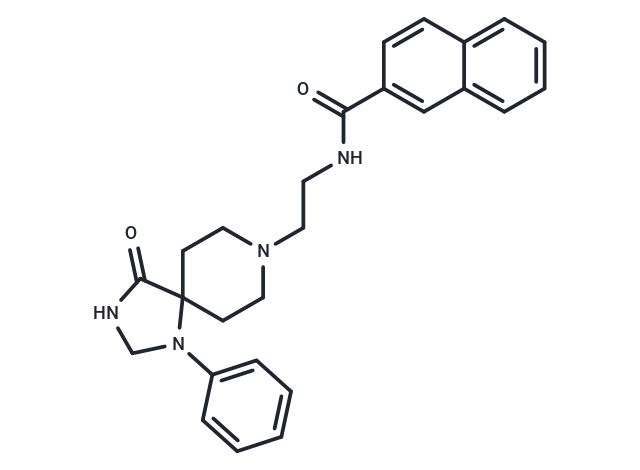Shopping Cart
Remove All Your shopping cart is currently empty
Your shopping cart is currently empty
CAY10594 is a potent phospholipase D2(PLD2) inhibitor. CAY10594 ameliorates acetaminophen-induced acute liver injury by regulating the phosphorylated-GSK-3β/JNK axis.

| Pack Size | Price | USA Warehouse | Global Warehouse | Quantity |
|---|---|---|---|---|
| 1 mg | $76 | In Stock | In Stock | |
| 5 mg | $163 | In Stock | In Stock | |
| 10 mg | $278 | In Stock | In Stock | |
| 25 mg | $497 | In Stock | In Stock | |
| 50 mg | $723 | In Stock | In Stock | |
| 100 mg | $987 | In Stock | In Stock | |
| 1 mL x 10 mM (in DMSO) | $178 | In Stock | In Stock |
| Description | CAY10594 is a potent phospholipase D2(PLD2) inhibitor. CAY10594 ameliorates acetaminophen-induced acute liver injury by regulating the phosphorylated-GSK-3β/JNK axis. |
| In vivo | CAY10594 administration markedly blocked the acute liver injury in a dose-dependent manner, showing almost complete inhibition with 8?mg/kg of CAY10594. During the pathological progress of acute liver injury, GSH levels are decreased, and this is significantly recovered upon the administration of CAY10594 at 6?hours post APAP challenge. GSK-3β (Serine 9)/JNK phosphorylation is mainly involved in APAP-induced liver injury. CAY10594 administration strongly blocked GSK-3β (Serine 9)/JNK phosphorylation in the APAP-induced acute liver injury model. Consistently, sustained JNK activation in the cytosol and mitochondria from hepatocytes were also decreased in CAY10594-treated mice. Many types of immune cells are also implicated in APAP-induced liver injury. However, neutrophil and monocyte populations were not different between vehicle- and CAY10594-administered mice which are challenged with APAP. Therapeutic administration of CAY10594 also significantly attenuated liver damage caused by the APAP challenge, eliciting an enhanced survival rate[1]. |
| Animal Research | Mice were fasted for 16?hours before APAP injection. APAP (500?mg/kg) was administered with oral gavage in mice. CAY10594 (N-[2-(4-oxo-1-phenyl-1,3,8-triazaspiro[4,5]dec-8-yl)ethyl]-2-naphthalene carboxamide)23 was dissolved in 1% DMSO and intraperitoneally administered to mice 30?minutes prior to APAP injection for examining protective effects or after 3?hours from APAP challenge for investigating therapeutic effects of CAY10594[1]. |
| Molecular Weight | 428.53 |
| Formula | C26H28N4O2 |
| Cas No. | 1130067-34-3 |
| Smiles | O=C(NCCN1CCC2(CC1)N(CNC2=O)c1ccccc1)c1ccc2ccccc2c1 |
| Relative Density. | 1.29 g/cm3 (Predicted) |
| Color | White |
| Appearance | Solid |
| Storage | Powder: -20°C for 3 years | In solvent: -80°C for 1 year | Shipping with blue ice/Shipping at ambient temperature. | |||||||||||||||||||||||||
| Solubility Information | DMSO: 20 mg/mL (46.67 mM), Sonication is recommended. | |||||||||||||||||||||||||
| In Vivo Formulation | 10% DMSO+40% PEG300+5% Tween 80+45% Saline: 1 mg/mL (2.33 mM), Sonication is recommended. Please add the solvents sequentially, clarifying the solution as much as possible before adding the next one. Dissolve by heating and/or sonication if necessary. Working solution is recommended to be prepared and used immediately. The formulation provided above is for reference purposes only. In vivo formulations may vary and should be modified based on specific experimental conditions. | |||||||||||||||||||||||||
Solution Preparation Table | ||||||||||||||||||||||||||
DMSO
| ||||||||||||||||||||||||||
| Size | Quantity | Unit Price | Amount | Operation |
|---|

Copyright © 2015-2025 TargetMol Chemicals Inc. All Rights Reserved.